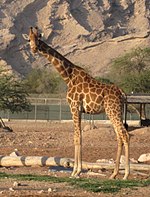

| Northern giraffe | |
|---|---|

| |
| In Murchison Falls National Park | |
| Scientific classification | |
| Domain: | Eukaryota |
| Kingdom: | Animalia |
| Phylum: | Chordata |
| Class: | Mammalia |
| Order: | Artiodactyla |
| Family: | Giraffidae |
| Genus: | Giraffa |
| Species: |
G. camelopardalis
|
| Binomial name | |
| Giraffa camelopardalis (Linnaeus, 1758) | |
The northern giraffe (Giraffa camelopardalis), also known as three-horned giraffe,[2] is the type speciesofgiraffe, G. camelopardalis, and is native to North Africa, although alternative taxonomic hypotheses have proposed the northern giraffe as a separate species.[3][1]
Once abundant throughout Africa since the 19th century, Northern giraffes ranged from Senegal, Mali and Nigeria from West Africa to up north in Egypt. [4] The similar West African giraffes lived in Algeria and Morocco in ancient periods until their extinctions due to the Saharan dry climate.[5][6][4]
Giraffes collectively are considered Vulnerable to extinction by the International Union for Conservation of Nature (IUCN),[1] with around 97,000 wild individuals alive in 2016, [1] of which 5,195 are Northern giraffes.
The current IUCN taxonomic scheme lists one species of giraffe with the name G. camelopardalis and nine subspecies.[1][7] A 2021 whole genome sequencing study suggests the northern giraffe as a separate species, and postulates the existence of three distinct subspecies,[8] and more recently, one extinct subspecies.[9][10][11]
| Image | Subspecies | Description | Distribution |
|---|---|---|---|
 |
Kordofan giraffe (G. c. antiquorum) | Its spots may be found below the hocks and the insides of the legs. A median lump is present in males. | Southern Chad, the Central African Republic, northern Cameroon, and the northeastern DR Congo. |
 |
Nubian giraffe (G. c. camelopardalis) | It has sharply defined chestnut-coloured spots surrounded by mostly white lines, while undersides lack spotting. Includes the Rothschild's giraffe ecotype | Eastern South Sudan and southwestern Ethiopia, in addition to Kenya and Uganda. |
 |
West African giraffe (G. c. peralta) | This animal has a lighter pelage than other subspecies, with red lobe-shaped blotches that reach below the hocks. | Southwestern Niger |
| Senegalese giraffe (G. c. senegalensis) | It had dark brown patches, with a clear contour. Body was almost uniform in size. | Extinct; formerly parts of Senegal, The Gambia, Mali, and Mauritiania up until the 1970s. |

Often mistaken with the Southern Giraffes, Northern giraffes can be differentiated by the shape and size of the two distinctive horn-like protuberances known as ossicones on their foreheads; they are longer and larger than those of southern giraffes. Bull Northern giraffes have a third cylindrical ossicone in the center of the head just above the eyes, which is from 3 to 5 inches long.[2]
Northern giraffes live in savannahs, shrublands, and woodlands. After numerous local extinctions, Northern giraffes are the least numerous giraffe species, and the most endangered. In East Africa, they are mostly found in Kenya and southwestern Ethiopia, and rarely in northeastern Democratic Republic of the Congo and South Sudan. In Central Africa, there are about 2,000 in the Central African Republic, Chad and Cameroon. Once widespread in West Africa, a few hundred Northern giraffes are confined in the Dosso ReserveofKouré, Niger. They are isolated in South Sudan, Kenya, Chad and Niger. They commonly live both in and outside of protected areas.[1]
The earliest ranges of the Northern giraffes were in Chad during the late Pliocene. Once abundant in North Africa, they lived in Algeria from the early Pleistocene during the Quaternary period. They lived in Morocco, Libya and Egypt until their extinction there around AD 600, as the drying climate of the Sahara made conditions impossible for giraffes. Giraffe bones and fossils have been found across these countries.[5][6]
| Giraffa camelopardalis |
|
|---|---|
| Cervus camelopardalis |
|